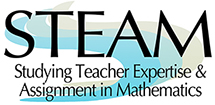

Quasi-experimental and qualitative designs will be used to answer the research questions. For Research Questions 1a and 2, in which EMS teachers and their students are compared to non-EMS teachers and students, we have recruited non-EMS teachers who "match" each of the participating self-contained EMS teachers in terms of grade level, years of experience, school size, percentage of students free and reduced lunch in the school, and prior MAP scores for their grade level at that school. By purposefully selecting matching teachers, we help ensure that the classrooms of EMS and non-EMS teachers share similar characteristics aside from the teachers' EMS status. For Research Question 1b, we will compare the state mathematics assessment scores of students taught by EMS teachers with departmental assignments to the scores of students taught by EMS teachers with self-contained teaching assignments, and use prior-year data to account for students' prior achievement. For Question 2, we will compare the scores of students with self-contained EMS teachers to the scores of students taught by the matching non-EMS teachers.
We define the "departmental teaching condition" as a school structure where, rather than teaching all subjects to a single class of students, a single teacher is responsible for teaching the same mathematics lesson to multiple (two or more) classes of students over the course of a school day. Departmentalized teachers might teach other subjects in addition to mathematics. For example, a school employing a departmental structure may assign a teacher to teach both mathematics and science to multiple groups of students or utilize them in other capacities (e.g., homeroom) when not teaching mathematics. Because of the scarcity of resources in most public schools, we do not anticipate that teachers in the departmental condition will have significantly more overall planning time or professional development opportunities than teachers in the self-contained condition. However, we are collecting data from project teachers to document such differences, if they exist. The departmentalized condition does not include an assignment where a teacher provides additional mathematics instruction to students who are "pulled out" of regular classrooms, or where the teacher is primarily employed as a math coach who provides support to other teachers.
For Research Question 3, case study methods (Yin, 2014) are being used to help explain the links between teaching condition and teachers' opportunities to utilize their expertise in mathematics teaching and leadership. Specifically, we are investigating the experiences of eight EMS certified teachers (case study teachers), five of whom are teaching within a departmental model. These teachers have been selected based on our desire for contextual variation in terms of school size, mathematics curriculum, departmentalized structure, and administrative support for mathematics instruction. Our goal is to investigate how the different departmentalized structures and sets of contextual variables might enable individual teachers to utilize their expertise in more efficient or effective ways. For example, does the opportunity to enact the same lesson multiple times during the course of a school day enable teachers to construct and act upon hypotheses about how their teaching affects student learning? Does the increased proportion of time thinking about and planning specifically for mathematics teaching result in instruction that is better able to anticipate students' mathematical thinking and respond appropriately? Does the removal of transitions from subject to subject during the school day result in an increased focus on mathematics teaching and learning? Answers to these and other questions will be used to generate plausible explanations for why and how the departmental condition yields (or fails to yield) gains in student learning.